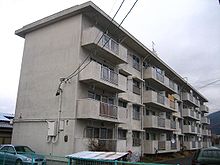- Danchi
-
Danchi (団地 lit. "group land") is the Japanese word for a large cluster of apartment buildings of a particular style and design, typically built as public housing by a government authority.
The Japan Housing Corporation (JHC), now known as the Urban Renaissance Agency (UR), was founded in 1955. During the 1950s, 60's, and 70's, the JHC built many danchi in suburban areas to offset the housing demand of the then-increasing Japanese population.[1]
Today, fewer and fewer Japanese live in the gradually aging danchi,[citation needed][dubious ] generally preferring individual housing or condominiums, known as mansion (マンション manshon). Many danchi are owned by large corporations, who charge low or no rent to employees to encourage them to live alongside their colleagues in order to foster a corporate "family" atmosphere.
The rent payment for a danchi is much cheaper than that of a mansion or a mortgage, but for public danchi the prospective tenant must usually participate in a lottery in order to be assigned an open apartment. Some danchi built in recent years are in fact quite modern and spacious, but since there is a lottery for assignment the waiting list can often run years. On the other hand, there continue to be many open slots in older, distant danchi.
Residents in UR danchi do not have to pay key money or contract renewal fees, making the residences cheaper than comparable housing even if the monthly rents are equivalent.[2]
Danchis have a bad connotation in Japan as being known as a Japanese slum, because most of Japan's poor live there.
See also
References
- ^ Yamashita, Tsutomu (2007-12-09). "Showa 30s Movie Revives Interest in Danchi". column (Asahi Shimbun): p. 15.
- ^ Brasor, Phillip, and Masako Tsubuku, "There are advantages to choosing UR property", Japan Times, 6 September 2011, p. 10.
External links
Categories:- Japanese building and structure stubs
- Architecture stubs
- Buildings and structures in Japan
Wikimedia Foundation. 2010.

